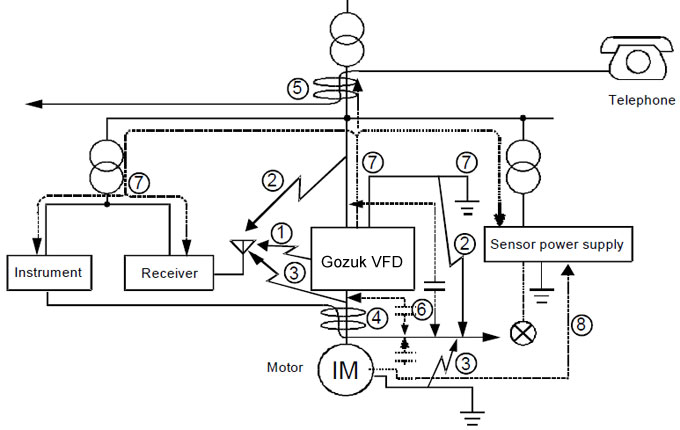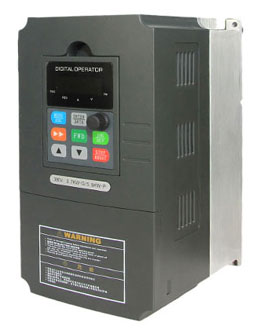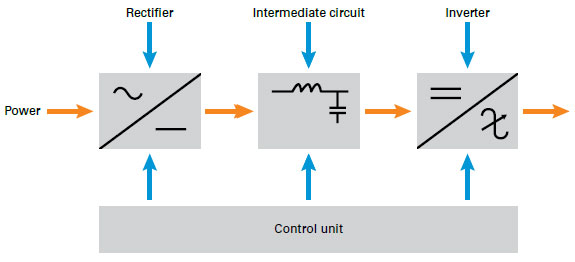Variable Frequency Drive Noise
Most variable frequency drives (VFD) employ the PWM control method. Variable frequency drives generate the AC by switching the main circuit elements. This principle of operation can be referred to as the noise source.
Note: The noise mentioned here and the harmonics mentioned here are sometimes thought of as interchangeable. This is because both of them affect other electrical equipment. Generally, however, the harmonics commonly refer to waves with a frequency between 40th and 50th (2.4 to 3kHz) whereas noise commonly refers to waves with a frequency of tens of kilohertz or higher.
Noise types and propagation paths
Noises generated from a variable frequency drive are broadly classified into the following types: those radiated from the cables connected to the VFD and VFD main circuits (I/O), those electromagnetically and electrostatically induced from the signal cables of the peripheral devices close to the main circuit power supply, and those transmitted through the power supply cables.

a). Air-propagated noise (Paths 1) to 3))
This noise is generated by a variable frequency drive and radiated to the air. The paths of this noise can be classified into the following three types.
This noise is generated and transmitted when power cables or signal cables of peripheral devices cross a magnetic field generated by the current that is input to or output from a variable frequency drive.
c). Electrostatic induction noise (Path 6))
This noise is combined capacitances that are generated by the principle of electrostatic induction and transmitted through I/O cables of a variable frequency drive.
d). Cable-propagated noise (Path 7))
This noise is a high-frequency noise that is generated inside the variable frequency drive and transmitted to peripheral devices through cables on the power supply side.
These noises tend to gain the lower noise level as the noise frequency band is higher. Generally, the noise level is low enough not to be problematic in frequencies of 30MHz or higher.
Measures against noise
Although there are many noise propagation paths, noise sources can broadly be classified into the following three types:
An effective method is to install a filter between a variable frequency drive and the power supply cable.

Installing the radio noise filter or line noise filter to the output side of the variable frequency drive is a method to reduce the radiated noises. Generally, however, a metal pipe is used.
c) Reducing noises radiated from a variable frequency drive
Noises generated from this variable frequency drive are relatively small and less problematic. However, when a variable frequency drive is installed close to devices easily affected by noises, it is required to house the variable frequency drive in a metal case and install a noise filter on the power supply side. Also, for the output side, connect a metal pipe to the case.
Note: The noise mentioned here and the harmonics mentioned here are sometimes thought of as interchangeable. This is because both of them affect other electrical equipment. Generally, however, the harmonics commonly refer to waves with a frequency between 40th and 50th (2.4 to 3kHz) whereas noise commonly refers to waves with a frequency of tens of kilohertz or higher.
Noise types and propagation paths
Noises generated from a variable frequency drive are broadly classified into the following types: those radiated from the cables connected to the VFD and VFD main circuits (I/O), those electromagnetically and electrostatically induced from the signal cables of the peripheral devices close to the main circuit power supply, and those transmitted through the power supply cables.

a). Air-propagated noise (Paths 1) to 3))
This noise is generated by a variable frequency drive and radiated to the air. The paths of this noise can be classified into the following three types.
- Radiated from variable frequency drive.
- Radiated from input cables.
- Radiated from motor connection cables.
This noise is generated and transmitted when power cables or signal cables of peripheral devices cross a magnetic field generated by the current that is input to or output from a variable frequency drive.
c). Electrostatic induction noise (Path 6))
This noise is combined capacitances that are generated by the principle of electrostatic induction and transmitted through I/O cables of a variable frequency drive.
d). Cable-propagated noise (Path 7))
This noise is a high-frequency noise that is generated inside the variable frequency drive and transmitted to peripheral devices through cables on the power supply side.
These noises tend to gain the lower noise level as the noise frequency band is higher. Generally, the noise level is low enough not to be problematic in frequencies of 30MHz or higher.
Measures against noise
Although there are many noise propagation paths, noise sources can broadly be classified into the following three types:
- Propagation, induction or radiation from an input power supply cable
- Induction or radiation from motor connection cables
- Radiation from a variable frequency drive
An effective method is to install a filter between a variable frequency drive and the power supply cable.

-
Radio noise filter.
-
Line noise filter.
-
Combination of radio noise filter and line noise filter.
- Noise-cutting transformer.
Installing the radio noise filter or line noise filter to the output side of the variable frequency drive is a method to reduce the radiated noises. Generally, however, a metal pipe is used.
c) Reducing noises radiated from a variable frequency drive
Noises generated from this variable frequency drive are relatively small and less problematic. However, when a variable frequency drive is installed close to devices easily affected by noises, it is required to house the variable frequency drive in a metal case and install a noise filter on the power supply side. Also, for the output side, connect a metal pipe to the case.
Post a Comment:
You may also like:
Featured Articles
PWM Variable Frequency Drive ...
 Pulse Width Modulation (PWM) voltage source variable frequency drives (VFD) presently comprehend the most used equipments to feed ...
Pulse Width Modulation (PWM) voltage source variable frequency drives (VFD) presently comprehend the most used equipments to feed ...
 Pulse Width Modulation (PWM) voltage source variable frequency drives (VFD) presently comprehend the most used equipments to feed ...
Pulse Width Modulation (PWM) voltage source variable frequency drives (VFD) presently comprehend the most used equipments to feed ...Variable Frequency Drive Working ...
 This guideline discusses variable frequency drive (VFD) basic working principle and how installing variable frequency drives in ...
This guideline discusses variable frequency drive (VFD) basic working principle and how installing variable frequency drives in ...
 This guideline discusses variable frequency drive (VFD) basic working principle and how installing variable frequency drives in ...
This guideline discusses variable frequency drive (VFD) basic working principle and how installing variable frequency drives in ...
Variable Frequency Drives control AC motor for energy savings by adjustable speed, for short VFD, also named variable speed drives and frequency inverter.
